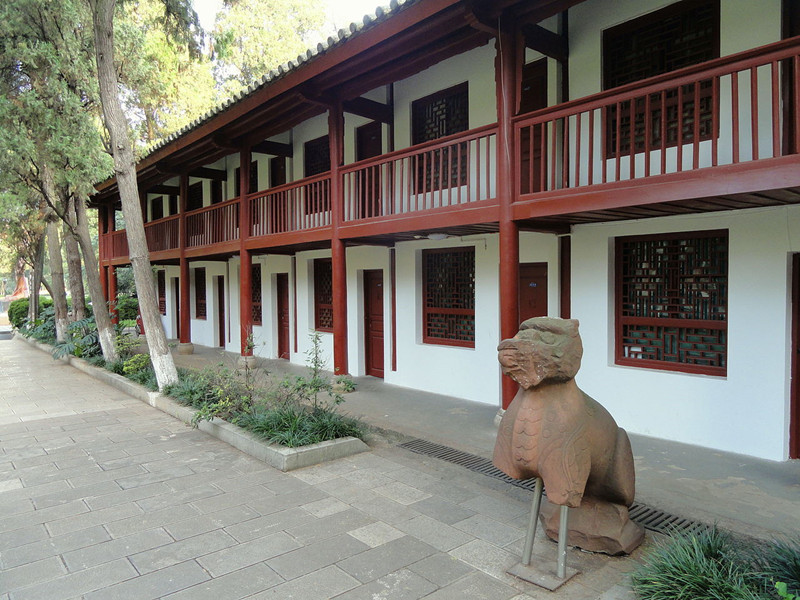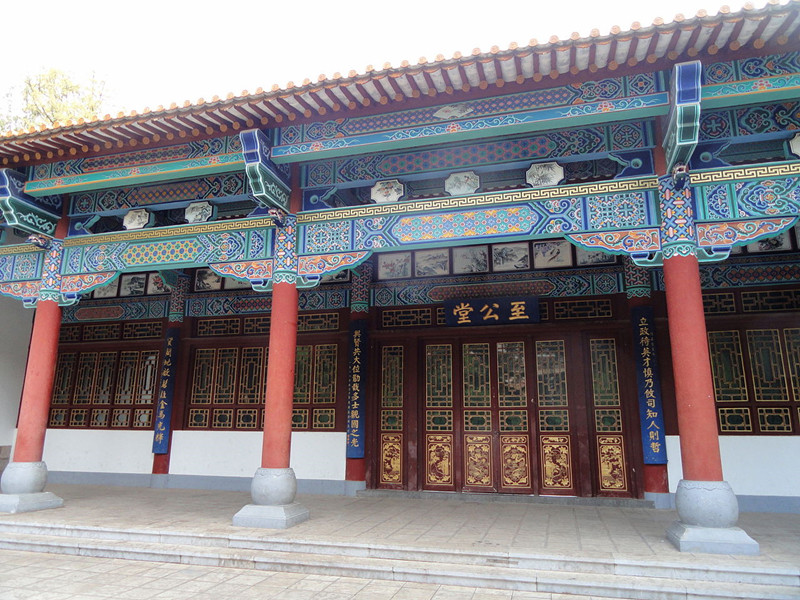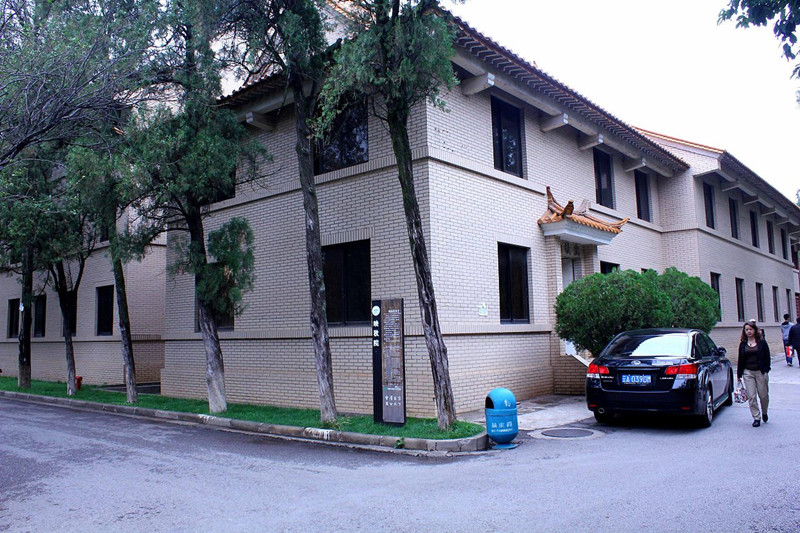
Yunnan Gongyuan Examination Hall in Kunming
The current site of Yunnan University (云南大学) was originally the Gongyuan (贡院) of the Ming and Qing Dynasties, serving as the examination hall for the provincial imperial examinations (乡试). The Gongyuan hosted these examinations every three years, with examination rooms arranged on either side of the Zhi Gong Tang (至公堂), organized in neat rows and numbered using the “Thousand Character Classic” (千字文). The entrance was equipped with a gate for locking purposes. The eastern examination area had 900 rooms, of which 40 remain today, designed as two-story brick-and-wood structures, featuring corridors both inside and out. It has always been the cultural and educational center of Yunnan.
Chinese Name: 云南贡院旧址
Geographical Location: Yuhua District, Kunming, Yunnan Province (云南省昆明市五华区)
Dynasty: Ming (明) – Republic of China (民国)
Type: Ancient Architecture and Historical Memorial
Main Attractions
- Hui Ze Yuan (会泽院)
- Feng Jie Pavilion (风节亭)
- Ying Qiu Yuan (映秋院)
Introduction
The Gongyuan was the examination hall for the provincial imperial examinations (乡试) in ancient China. The Yunnan Gongyuan is situated within the current Yunnan University campus, including the Zhi Gong Tang, Donghao Building (东号舍), Hui Ze Yuan, Ying Qiu Yuan, Bell Tower (钟楼), and other buildings. Among these, only the Zhi Gong Tang and Donghao Building are original structures from the Gongyuan; the others were built during the Republic of China era. In the early Ming Dynasty, candidates from Yunnan had to travel to the far-off Ying Tian Fu (应天府, now Nanjing) to take the provincial examinations. In the ninth year of the Yongle era (公元1411年), the court ordered Yunnan to hold its own examinations and began constructing the Gongyuan. The earliest Gongyuan was built east of the Yunnan Provincial Administration, around the current Changchun Road and Weiyuan Street. Due to overcrowding, it could not meet the cultural development needs of Yunnan, so in the twelfth year of the Hongzhi era (公元1499年), a new Yunnan Gongyuan was built at the current location of Yunnan University’s East Lu Garden. This site is described as “supported by city walls, facing the emerald lake, perched high for a commanding view, like a crouching tiger,” a rare and auspicious place. It is one of the remaining physical representations of over 1,300 years of imperial examinations.
The Gongyuan, Zhi Gong Tang, Lun Cai Tang (now Ze Qing Tang), Hao She, Hui Ze Yuan, Ying Qiu Yuan, and related inscriptions are important empirical evidence for studying the imperial examination system in Yunnan during the Ming and Qing Dynasties, as well as modern higher education in Yunnan. In 1987, it was listed as a provincial key cultural relic protection unit.
Layout
The layout of the Gongyuan is rigorous, with the central hall, Zhi Gong Tang, being the place that determined the fate of the candidates. This building features a two-slope single-eaved hard mountain-style architecture, with doors on the north and south sides. The southern entrance is lined with windows, while the central section has decorative carved wooden doors adorned with gold powder. Above the main entrance hangs a horizontal plaque inscribed with “Zhi Gong Tang,” written by the Ming Dynasty scholar Yan Menghang (严孟衡). On either side of the entrance, there are couplets; the inner couplet is an old line from the Qing Dynasty, “Establishing governance waits for talented individuals, be cautious in your responsibilities, knowing people brings wisdom; sharing high positions with the virtuous, encouraging many scholars, observing the light of the nation.” The outer couplet, composed by the top scholar Na Wenfeng (那文风原) in the fifty-ninth year of Qianlong (公元1794年), reads: “The literary tide opens to heaven, winds of tigers and dragons meet; the worthy await behind the blue chicken and golden horse shines.” On the outer eastern wall is embedded a stele from the third year of Kangxi (公元1664年), written by the Governor of Yunnan Bian San (卞三), which is the “Record of the Reconstruction of the Gongyuan.” The entire structure is solemn and elegant, with Hui Ze Yuan positioned both in front and behind, creating a harmonious interplay. It was refurbished in 1983.
Behind Zhi Gong Tang was Heng Jian Tang (衡鉴堂), which was demolished during the construction of the library. This hall was where the examination papers were evaluated, followed by rooms for supervisors, examiners, and four additional rooms designated for paper distribution, collection, and registration during the examinations. In front stood Ming Yuan Lou (明远楼), which was also demolished during the construction of Hui Ze Yuan. On either side of the building were the examination areas where candidates stayed and took the exams. There were tall towers at each corner, and further south lay the “Ke Jia Ying Cai” Archway (科甲英才坊), which was destroyed at the end of the Ming Dynasty. The entrance featured a flagpole, with an archway on each side; the left one was “Teng Jiao” (腾蛟), inscribed with “Seeking Talent for the Nation,” while the right one was “Qi Feng” (起凤), inscribed with “Studying for the Scholars.” These archways were demolished during the Cultural Revolution. The Gongyuan has undergone several renovations but has maintained this layout while expanding.
Historical Changes
In 1999, renovations occurred, adding 775 rooms in the western examination area in front of the bell tower. Each examination room was designed to eight feet in size, with five feet for the students and three feet for the street. The interior was originally mud, which became muddy during rain, so it was later paved with clam shells. In the sixth year of Daoguang (公元1821年), the examination rooms were rebuilt with brick flooring. During the third year of Kangxi (公元1664年), there were more than 2,800 rooms, which increased to 4,865 rooms by the forty-seventh year of Kangxi (公元1708年) and further expanded in the sixth year of Jiaqing (公元1801年) with the addition of the western examination rooms near the Physics Building (物理馆). The provincial examinations began on the ninth day of the eighth month, with three sessions lasting three days each, with candidates entering the examination rooms on the eighth day. Each candidate received a room, and a cannon signaled the closing of the dragon gate and entrance, which only opened when papers were submitted, with a gong used for timekeeping. In addition to the Yunnan candidates, those from Guizhou also participated in examinations at the Gongyuan. As the feudal system declined, the Yunnan Gongyuan gradually fell into disuse. During the Xianfeng era (公元1851—1861年), the Gongyuan was temporarily occupied by military troops. In the second year of Tongzhi (公元1863年), during the Lantern Festival incident, the army led by Ma Rong occupied the provincial capital, taking over the north gate tower and Gongyuan. The imperial examinations were abolished in the late Qing Dynasty, giving way to modern education, and the last two provincial examinations were held at the Gongyuan in the twenty-ninth year of Guangxu (公元1903年). In the first year of the Xuantong era (公元1909年), the Intermediate Agricultural School (中等农业学堂) was moved to the Gongyuan, marking the end of the history of Yunnan Gongyuan.
Three significant events in the history of the Gongyuan are worth mentioning.
- At the turn of the Ming and Qing Dynasties, the Gongyuan briefly became the center of resistance against the Qing Dynasty in Southwest China. In the tenth year of the Southern Ming Dynasty (公元1656年), the Yongli Emperor arrived in Kunming, using the Gongyuan as his temporary imperial palace to organize the resistance against the Qing, relocating to the Tai Wang Fu established by Sun Kewang on Wuhua Mountain the following August.
- In the twenty-fourth year of the Jiaqing era (公元1819年), Lin Zexu was appointed as the chief examiner for the Yunnan provincial examination. After the examinations, he compiled 14 elegant pieces from the examination papers and wrote the “Preface to the Records of the Yunnan Provincial Examination” and “Interim Examination Papers for Yunnan,” reflecting his concern for education in Yunnan.
- On July 15, 1946, at a report meeting on the martyrdom of Mr. Li Gongpu, held in Zhi Gong Tang, Mr. Wen Yiduo stood up angrily and denounced the atrocities of the Kuomintang.
Main Buildings
Hui Ze Yuan
Directly in front of Zhi Gong Tang is Hui Ze Yuan (会泽院), established when Donglu University (now Yunnan University) was founded by Yunnan Provincial Governor Tang Jiyao (唐继尧) in the eleventh year of the Republic (公元1922年), completed in the thirteenth year (公元1924年). Hui Ze Yuan is shaped like an “H,” originally comprising two floors and a basement, with doors on all sides on the first floor. The walls of the entire courtyard are surrounded by stone strips, giving it a unique character. The roof features an open terrace for expansive views; later, the eastern terrace became a flower garden, while the western terrace was developed into an office area, with the foundation still visible today.
Ying Qiu Yuan
Ying Qiu Yuan (映秋院), located at the back of the Zhi Gong Tang, was built in the early years of the Republic of China (公元1912—1949年) and has undergone various renovations. The yard features a dense cover of trees, offering a unique tranquility. The walls are thick, and the entire courtyard is low, resulting in an overall sense of warmth, making it an excellent place for introspection and study.
Ming Yu Lou
Ming Yu Lou (明育楼), which is located on the side of Hui Ze Yuan, was built in the first year of the Republic (公元1912年), with a rectangular building resembling a pagoda. The upper floor features an open balcony, while the lower floor serves as a storage area. The building has a concrete foundation and brick walls, allowing the roof to be constructed with thick wooden beams to accommodate large crowds during lectures. Today, the building continues to serve educational purposes.
Bell Tower
The Bell Tower (钟楼) stands to the right of Zhi Gong Tang, a three-story building housing a bell made from a special alloy of brass. It is used for significant ceremonies, often tolling to mark the passing of important events and public gatherings, reflecting the historical significance of the Gongyuan.
Visiting Information
- Visiting Hours: Open to the public. Specific opening hours may vary, so check in advance.
- Location: The Gongyuan is situated within the campus of Yunnan University, easily accessible from central Kunming.
- Transportation: Public transportation options are available, including buses and taxis, making it convenient to reach the site.
The Yunnan Gongyuan is not only a historical site but also a cultural hub, reflecting the educational traditions of the region. Visitors can explore the architecture and gardens while appreciating the rich history that shaped Yunnan’s academic landscape.




 7 Days GolfingTour
7 Days GolfingTour
 8 Days Group Tour
8 Days Group Tour
 8 Days Yunnan Tour
8 Days Yunnan Tour
 7 Days Shangri La Hiking
7 Days Shangri La Hiking
 11 Days Yunnan Tour
11 Days Yunnan Tour
 6 Days Yuanyang Terraces
6 Days Yuanyang Terraces
 11 Days Yunnan Tour
11 Days Yunnan Tour
 8 Days South Yunnan
8 Days South Yunnan
 7 Days Tea Tour
7 Days Tea Tour
 8 Days Muslim Tour
8 Days Muslim Tour
 12 Days Self-Driving
12 Days Self-Driving
 4 Days Haba Climbing
4 Days Haba Climbing
 Tiger Leaping Gorge
Tiger Leaping Gorge
 Stone Forest
Stone Forest
 Yunnan-Tibet
Yunnan-Tibet
 Hani Rice Terraces
Hani Rice Terraces
 Kunming
Kunming
 Lijiang
Lijiang
 Shangri-la
Shangri-la
 Dali
Dali
 XishuangBanna
XishuangBanna
 Honghe
Honghe
 Kunming
Kunming
 Lijiang
Lijiang
 Shangri-la
Shangri-la
 Yuanyang Rice Terraces
Yuanyang Rice Terraces
 Nujiang
Nujiang
 XishuangBanna
XishuangBanna
 Spring City Golf
Spring City Golf
 Snow Mountain Golf
Snow Mountain Golf
 Stone Mountain Golf
Stone Mountain Golf



















